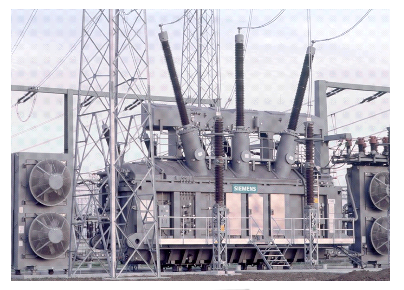-
High Voltage Engineering
Wk1 - Introduction, Electric Field
Wk2 - Insulation materials and breakdown mechanisms
Wk3 - Insulation in HV Plant Items
Wk4 - HV Insulation Coordination
Wk5 - HV generation, measurement, and testing
Wk6 - Seminar and revision
Prof. Chengke Zhou
Email: c.zhou@gcal.ac.uk -
Wk 1 - Introduction

Fig. 1 In power system in the UK, power is usually generated at a level of 11kV at large power stations. Power generated is then transmitted to load centre at voltage levels of 400/275/132kV. Power distribution voltage levels include mainly 33kV and 11kV. The distribution transformers reduce the voltage to 400V/230V, which supplies the houses, shopping centres, etc.
-
Voltage Classification
- Two factors considered in classifying a voltage as "high voltage" are the possibility of
- causing a spark in air,
- and the danger of electric shock by contact or proximity.
- The definitions may refer to the voltage between two conductors of a system, or between any conductor and ground.
- In electric power transmission engineering, high voltage is usually considered any voltage over approximately 35,000 volts.
This is a classification based on the design of apparatus and insulation.
- The International Electrotechnical Commission and its national counterparts (IET, IEEE, etc.) define high voltage as above 1000 V for alternating current, and at least 1500 V for direct current—and distinguish it from low voltage (50 to 1000 VAC or 120–1500 VDC) and extralow voltage (<50 VAC or <120 VDC) circuits. This is in the context of building wiring and the safety of electrical apparatus.
- Two factors considered in classifying a voltage as "high voltage" are the possibility of
-
HVAC systems
Pros:
• Easy transformation of energy between the different voltage levels,
• convenient and safe handling (application),Cons:
• transmission/ compensation of reactive power,
• stability problems,
• voltage differences and load angle issues at long lines.
HVDC (direct current)
• No (capacitive) charging currents
• Grid coupling (without rise of short-circuit current)
• No stability problems (frequency)
• Higher power transfer
• No inductive voltage drop
• No Skin-Effect
• High flexibility and controllability
Material properties in HV systems
The use of higher voltages introduces a number of new aspects that have to be taken into account in order to prevent current leakage or flashover.

-
Main Power Plant Items
• Generator
• substation
• Transformer
• Switchgear
• Cables/overhead lines
Rotating Machines

Large generator voltage is typically between 10 and 25 kV. The insulation of the stator bars relative to the stator slots poses a particularly difficult insulation problem in the light of the limited space, high voltage and temperature. Mica, bonded with epoxy resin is usually applied as insulation material.
Substation

The substations are the nodes in the power system where several lines and transformers are connected together. It hosts transformers, instrument transformers, switchgears, lines, cables, protection equipment, ancillary devices etc. Insulation coordination is important.
Transformers
• Materials: Oil and paper/pressboard
• Windings: layer or disc type

- Insert Content Here 7